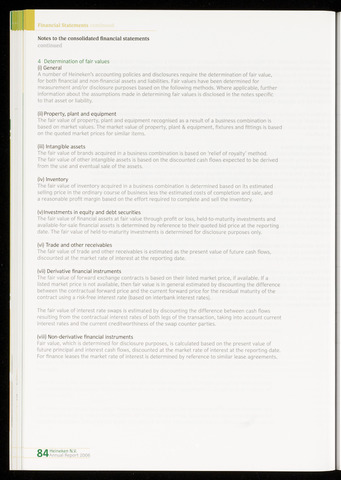Financial Statements col inure 1
Notes to the consolidated financial statements
continued
4 Determination of fair values
(i) General
A number of Heineken's accounting policies and disclosures require the determination of fair value,
for both financial and non-financial assets and liabilities. Fair values have been determined for
measurement and/or disclosure purposes based on the following methods. Where applicable, further
information about the assumptions made in determining fair values is disclosed in the notes specific
to that asset or liability.
(ii) Property, plant and equipment
The fair value of property, plant and equipment recognised as a result of a business combination is
based on market values. The market value of property, plant equipment, fixtures and fittings is based
on the quoted market prices for similar items.
(iii) Intangible assets
The fair value of brands acquired in a business combination is based on 'relief of royalty' method.
The fair value of other intangible assets is based on the discounted cash flows expected to be derived
from the use and eventual sale of the assets.
(iv) Inventory
The fair value of inventory acquired in a business combination is determined based on its estimated
selling price in the ordinary course of business less the estimated costs of completion and sale, and
a reasonable profit margin based on the effort required to complete and sell the inventory.
(v) Investments in equity and debt securities
The fair value of financial assets at fair value through profit or loss, held-to-maturity investments and
available-for-sale financial assets is determined by reference to their quoted bid price at the reporting
date. The fair value of held-to-maturity investments is determined for disclosure purposes only.
(vi) Trade and other receivables
The fair value of trade and other receivables is estimated as the present value of future cash flows,
discounted at the market rate of interest at the reporting date.
(vii) Derivative financial instruments
The fair value of forward exchange contracts is based on their listed market price, if available. If a
listed market price is not available, then fair value is in general estimated by discounting the difference
between the contractual forward price and the current forward price for the residual maturity of the
contract using a risk-free interest rate (based on interbank interest rates).
The fair value of interest rate swaps is estimated by discounting the difference between cash flows
resulting from the contractual interest rates of both legs of the transaction, taking into account current
interest rates and the current creditworthiness of the swap counter parties.
(viii) Non-derivative financial instruments
Fair value, which is determined for disclosure purposes, is calculated based on the present value of
future principal and interest cash flows, discounted at the market rate of interest at the reporting date.
For finance leases the market rate of interest is determined by reference to similar lease agreements.
O A Heineken N.V.
O^TAnnual Report 2006

